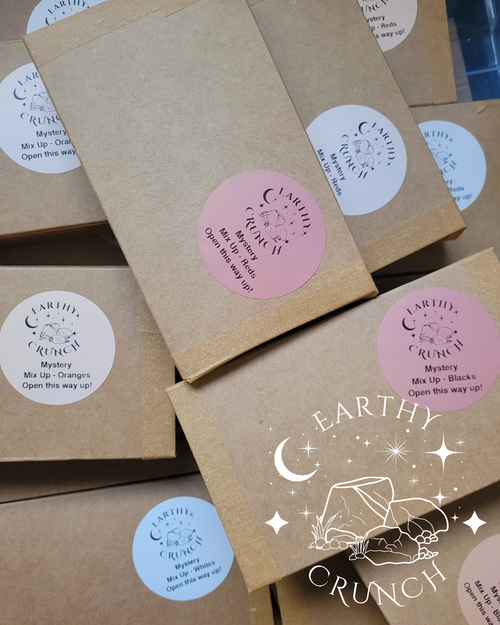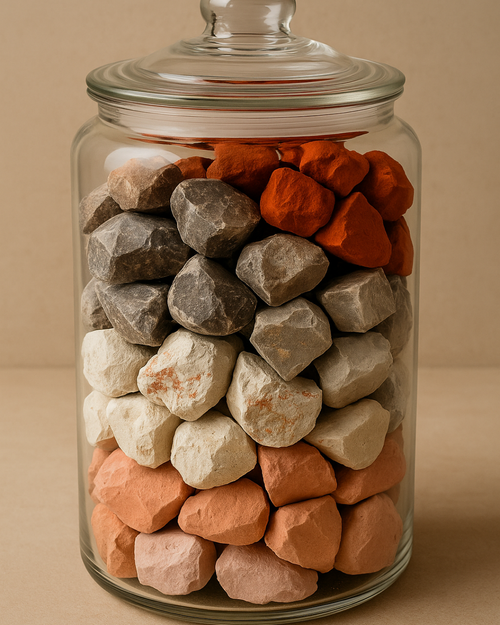Every crunch-lover knows that not all clays are created equal. Some are crisp and smoky, others soft and creamy; some crumble gently on the tongue, while others snap with satisfying force. But what gives each clay its signature texture, flavour, and “feel”?
The answer lies in its mineral profile – the natural blend of elements that shape everything from taste and colour to the way it crunches and dissolves.
Let’s dig into the science behind the crunch.
The mineral mix that matters
Clays are formed over millions of years as rocks break down and minerals settle into fine, earthy layers. The combination of minerals in each clay depends on where it comes from, how it formed, and what nature left behind in the soil.
Here are some of the key minerals that make a clay good to crunch:
1. Calcium
Calcium is one of the most abundant minerals in edible clays and chalks. It’s what gives chalky clays that familiar powdery crumble and cool, clean mouthfeel. High-calcium clays tend to taste slightly chalky or fresh, sometimes even milky, and they dissolve gently on the tongue.
It’s also why softer chalks – such as white school-chalk-style clays – have a lighter crunch that turns creamy fast.
2. Iron
Iron is the mineral behind those darker, bolder clays – think deep red, brown or black shades. It adds both colour and character, giving roasted and earthy clays their distinctive smoky tang and mineral-rich aroma.
Iron-heavy clays (like some Indian and African varieties) often have a stronger, more metallic flavour, with that “basement” or “soil after rain” note that clay enthusiasts adore. They also tend to crunch harder before breaking into flakes or fine dust.
3. Magnesium
Magnesium adds a subtle bitterness and that slightly alkaline edge that balances the natural earthiness of a clay. In texture, it helps create a firm but snappy crunch – the kind that breaks cleanly rather than crumbling too soon.
Clays with a good balance of magnesium are often described as smooth but sturdy, leaving a crisp, dry finish.
4. Silica
Silica gives clays their structure and grit. It’s the backbone of that signature “crack” when you bite down. High-silica clays are usually crunchier and glassier, creating a sharper snap and that faint sparkly glint in some raw chunks.
Too much silica, though, and a clay can feel a little sharp or dry – which is why the best clays balance silica with softer minerals like aluminium and magnesium for a smoother bite.
5. Aluminium and kaolinite
Aluminium compounds (found in kaolinite and other clay minerals) give clays their fine texture and binding strength. These minerals are what make a clay mouldable, dense, and satisfying to bite, without being too sandy.
Kaolinite-rich clays – such as kaolin and china clay – are often pale in colour, soft on the palate, and prized for their clean, neutral taste.
6. Trace minerals and regional flavour
Beyond the big players, it’s the trace minerals – the tiny amounts of sodium, potassium, manganese, and others – that add depth and uniqueness. They influence flavour subtleties like:
-
A smoky edge (from manganese or iron oxides)
-
A salty tang (from natural sodium or calcium salts)
-
A petrol or asphalt note (from deep mineral layers and organic residues)
This is why the same type of clay from two different regions can taste completely different – it’s nature’s own recipe.
Texture, flavour, and the “body response”
When you bite into a piece of clay, your senses are reacting to its mineral balance. The iron may trigger that earthy satisfaction, calcium gives the creamy melt, and magnesium delivers that clean, almost metallic snap.
Some people find iron-rich clays more grounding or energising, while high-calcium clays feel cooling and soothing. The “body response” to each clay can vary – some crave the soft crumble, others need that hard crack.
It’s part science, part sensory experience – and entirely personal.
What makes a clay “good to crunch”
A truly “good” clay has balance. It’s firm but not harsh, earthy but not bitter, and aromatic without tasting dusty. Its mineral profile creates contrast – a crisp start, a clean break, and a smooth, satisfying finish.
In other words, it’s not just the sound of the crunch that matters – it’s the chemistry behind it.
How Earthy Crunch UK approaches mineral quality
All of our clays, chalks and roasted treats are naturally sourced, air-dried, and aired out before packing to preserve their mineral structure and authentic flavour. Each variety is stored in its own separate container – never plastic baggies – to prevent contamination or microplastic leaching.
We don’t alter or add anything to change the mineral makeup; the crunch you experience is exactly as nature intended.
The takeaway
The minerals in clay are what make it more than just earth – they shape the flavour, crunch, and sensory satisfaction that so many of us crave. Iron brings boldness, calcium brings smoothness, and silica gives that irresistible snap.
So next time you bite into a favourite piece, remember: that crunch is millions of years in the making.



0 comments